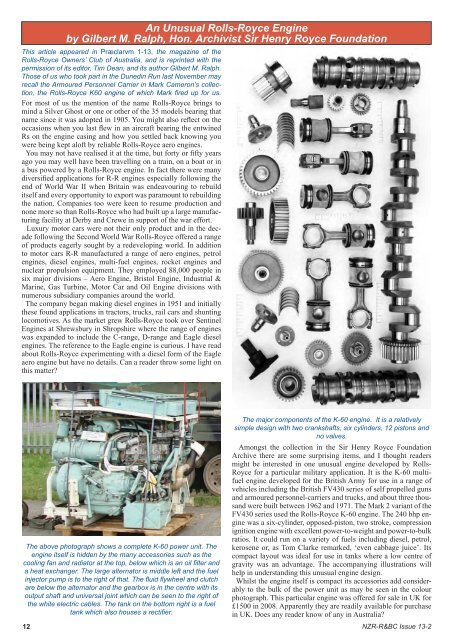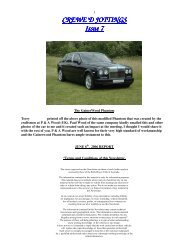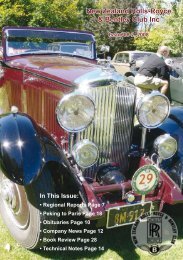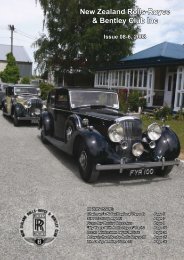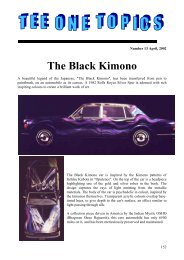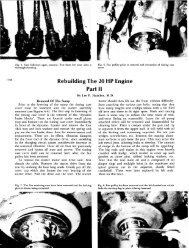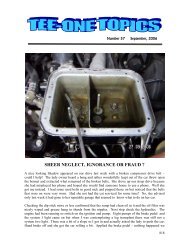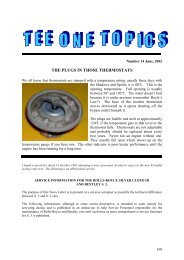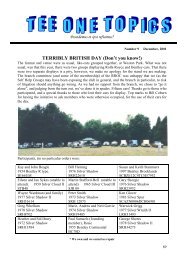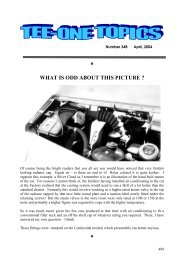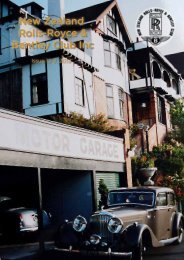New Zealand Rolls-Royce & Bentley Club Inc - The Enthusiasts ...
New Zealand Rolls-Royce & Bentley Club Inc - The Enthusiasts ...
New Zealand Rolls-Royce & Bentley Club Inc - The Enthusiasts ...
You also want an ePaper? Increase the reach of your titles
YUMPU automatically turns print PDFs into web optimized ePapers that Google loves.
An Unusual <strong>Rolls</strong>-<strong>Royce</strong> Engine<br />
by Gilbert M. Ralph, Hon. Archivist Sir Henry <strong>Royce</strong> Foundation<br />
This article appeared in Præclarvm 1-13, the magazine of the<br />
<strong>Rolls</strong>-<strong>Royce</strong> Owners’ <strong>Club</strong> of Australia, and is reprinted with the<br />
permission of its editor, Tim Dean, and its author Gilbert M. Ralph.<br />
Those of us who took part in the Dunedin Run last November may<br />
recall the Armoured Personnel Carrier in Mark Cameron’s collection,<br />
the <strong>Rolls</strong>-<strong>Royce</strong> K60 engine of which Mark fired up for us.<br />
For most of us the mention of the name <strong>Rolls</strong>-<strong>Royce</strong> brings to<br />
mind a Silver Ghost or one or other of the 35 models bearing that<br />
name since it was adopted in 1905. You might also reflect on the<br />
occasions when you last flew in an aircraft bearing the entwined<br />
Rs on the engine casing and how you settled back knowing you<br />
were being kept aloft by reliable <strong>Rolls</strong>-<strong>Royce</strong> aero engines.<br />
You may not have realised it at the time, but forty or fifty years<br />
ago you may well have been travelling on a train, on a boat or in<br />
a bus powered by a <strong>Rolls</strong>-<strong>Royce</strong> engine. In fact there were many<br />
diversified applications for R-R engines especially following the<br />
end of World War II when Britain was endeavouring to rebuild<br />
itself and every opportunity to export was paramount to rebuilding<br />
the nation. Companies too were keen to resume production and<br />
none more so than <strong>Rolls</strong>-<strong>Royce</strong> who had built up a large manufacturing<br />
facility at Derby and Crewe in support of the war effort.<br />
Luxury motor cars were not their only product and in the decade<br />
following the Second World War <strong>Rolls</strong>-<strong>Royce</strong> offered a range<br />
of products eagerly sought by a redeveloping world. In addition<br />
to motor cars R-R manufactured a range of aero engines, petrol<br />
engines, diesel engines, multi-fuel engines, rocket engines and<br />
nuclear propulsion equipment. <strong>The</strong>y employed 88,000 people in<br />
six major divisions – Aero Engine, Bristol Engine, Industrial &<br />
Marine, Gas Turbine, Motor Car and Oil Engine divisions with<br />
numerous subsidiary companies around the world.<br />
<strong>The</strong> company began making diesel engines in 1951 and initially<br />
these found applications in tractors, trucks, rail cars and shunting<br />
locomotives. As the market grew <strong>Rolls</strong>-<strong>Royce</strong> took over Sentinel<br />
Engines at Shrewsbury in Shropshire where the range of engines<br />
was expanded to include the C-range, D-range and Eagle diesel<br />
engines. <strong>The</strong> reference to the Eagle engine is curious. I have read<br />
about <strong>Rolls</strong>-<strong>Royce</strong> experimenting with a diesel form of the Eagle<br />
aero engine but have no details. Can a reader throw some light on<br />
this matter?<br />
Following the dismantling of <strong>Rolls</strong>-<strong>Royce</strong> in the 1980s the Oil<br />
Engine Division was sold to Perkins Diesels, a well established<br />
diesel engine manufacturing company based in Peterborough,<br />
UK, and I have no information on the fate of the K-60 engine.<br />
However, for those who wish to learn more about this unusual<br />
power unit Google ‘fv432 rolls royce K60’ and you will able to<br />
view one of these engines and hear it running.<br />
(Left, Above and Below) Mark Cameron’s FV432 personnel<br />
carrier powered by a K-60 engine. <strong>The</strong> accessibility to the K60<br />
engine through this tiny hatch may bring a wry smile to many<br />
faces. This vehicle is completely amphibious and can operate in<br />
extreme climatic conditions. Other variations included mortar and<br />
Wombat anti-tank gun carriers and a REME (Royal Electrical and<br />
Mechanical Engineers) mobile workshop.<br />
<strong>The</strong> above photograph shows a complete K-60 power unit. <strong>The</strong><br />
engine itself is hidden by the many accessories such as the<br />
cooling fan and radiator at the top, below which is an oil filter and<br />
a heat exchanger. <strong>The</strong> large alternator is middle left and the fuel<br />
injector pump is to the right of that. <strong>The</strong> fluid flywheel and clutch<br />
are below the alternator and the gearbox is in the centre with its<br />
output shaft and universal joint which can be seen to the right of<br />
the white electric cables. <strong>The</strong> tank on the bottom right is a fuel<br />
tank which also houses a rectifier.<br />
<strong>The</strong> major components of the K-60 engine. It is a relatively<br />
simple design with two crankshafts, six cylinders, 12 pistons and<br />
no valves.<br />
Amongst the collection in the Sir Henry <strong>Royce</strong> Foundation<br />
Archive there are some surprising items, and I thought readers<br />
might be interested in one unusual engine developed by <strong>Rolls</strong>-<br />
<strong>Royce</strong> for a particular military application. It is the K-60 multifuel<br />
engine developed for the British Army for use in a range of<br />
vehicles including the British FV430 series of self propelled guns<br />
and armoured personnel-carriers and trucks, and about three thousand<br />
were built between 1962 and 1971. <strong>The</strong> Mark 2 variant of the<br />
FV430 series used the <strong>Rolls</strong>-<strong>Royce</strong> K-60 engine. <strong>The</strong> 240 bhp engine<br />
was a six-cylinder, opposed-piston, two stroke, compression<br />
ignition engine with excellent power-to-weight and power-to-bulk<br />
ratios. It could run on a variety of fuels including diesel, petrol,<br />
kerosene or, as Tom Clarke remarked, ‘even cabbage juice’. Its<br />
compact layout was ideal for use in tanks where a low centre of<br />
gravity was an advantage. <strong>The</strong> accompanying illustrations will<br />
help in understanding this unusual engine design.<br />
Whilst the engine itself is compact its accessories add considerably<br />
to the bulk of the power unit as may be seen in the colour<br />
photograph. This particular engine was offered for sale in UK for<br />
£1500 in 2008. Apparently they are readily available for purchase<br />
in UK. Does any reader know of any in Australia?<br />
(Above) A cross-section drawing of a K-60 horizontally opposed,<br />
six cylinder, compression ignition engine developed for the British<br />
Army.<br />
(Above)<strong>The</strong> FV430 Abbott self propelled 105mm gun which used<br />
a <strong>Rolls</strong>-<strong>Royce</strong> K-60 engine and an Allison six speed automatic<br />
gearbox which was manufactured by <strong>Rolls</strong>-<strong>Royce</strong> under licence.<br />
(Left) Truck – An all-terrain armoured truck powered by a K-60<br />
engine.<br />
12 NZR-R&BC Issue 13-2 NZR-R&BC Issue 13-2<br />
13


